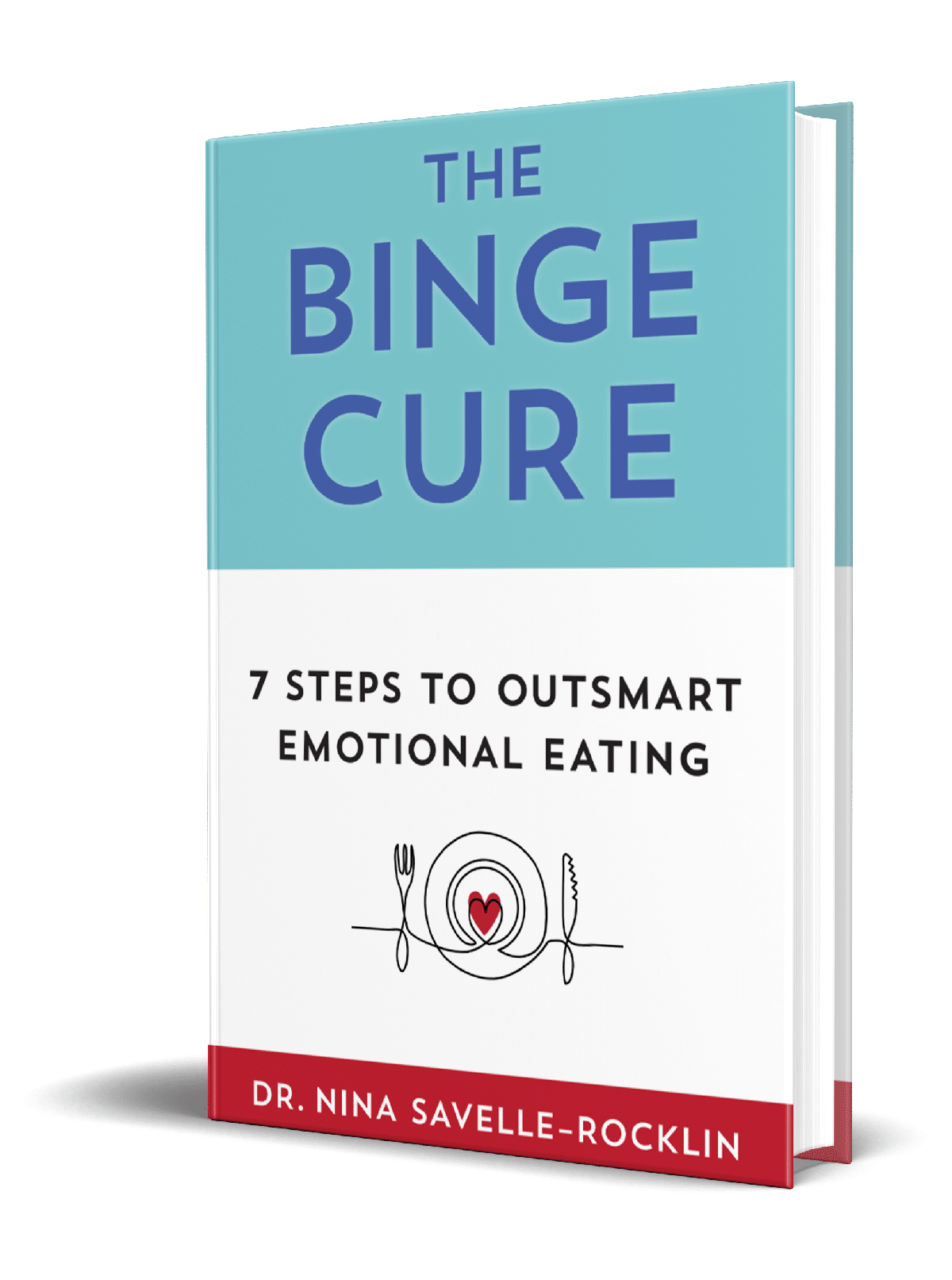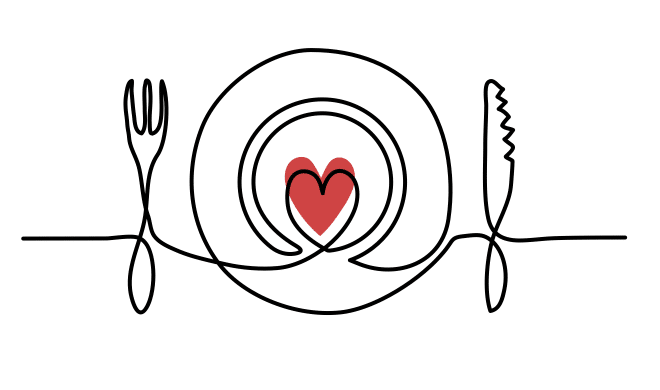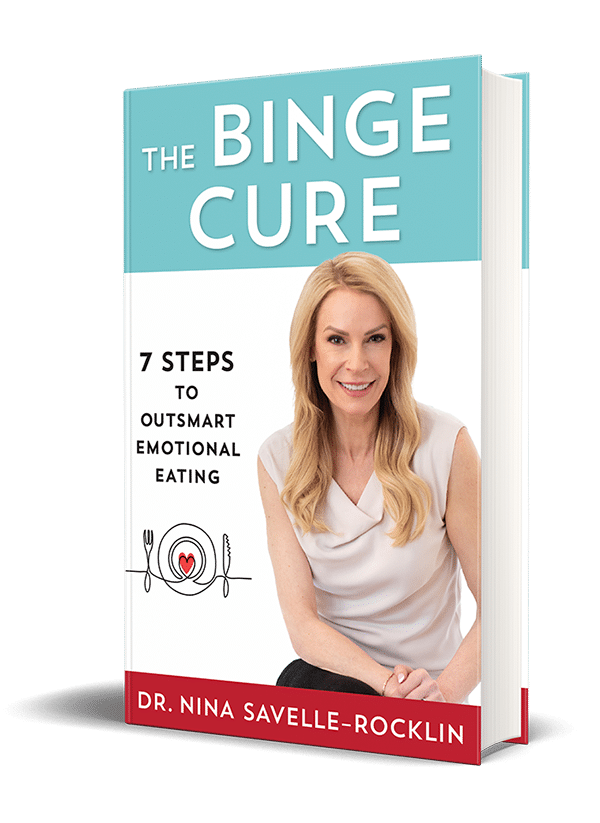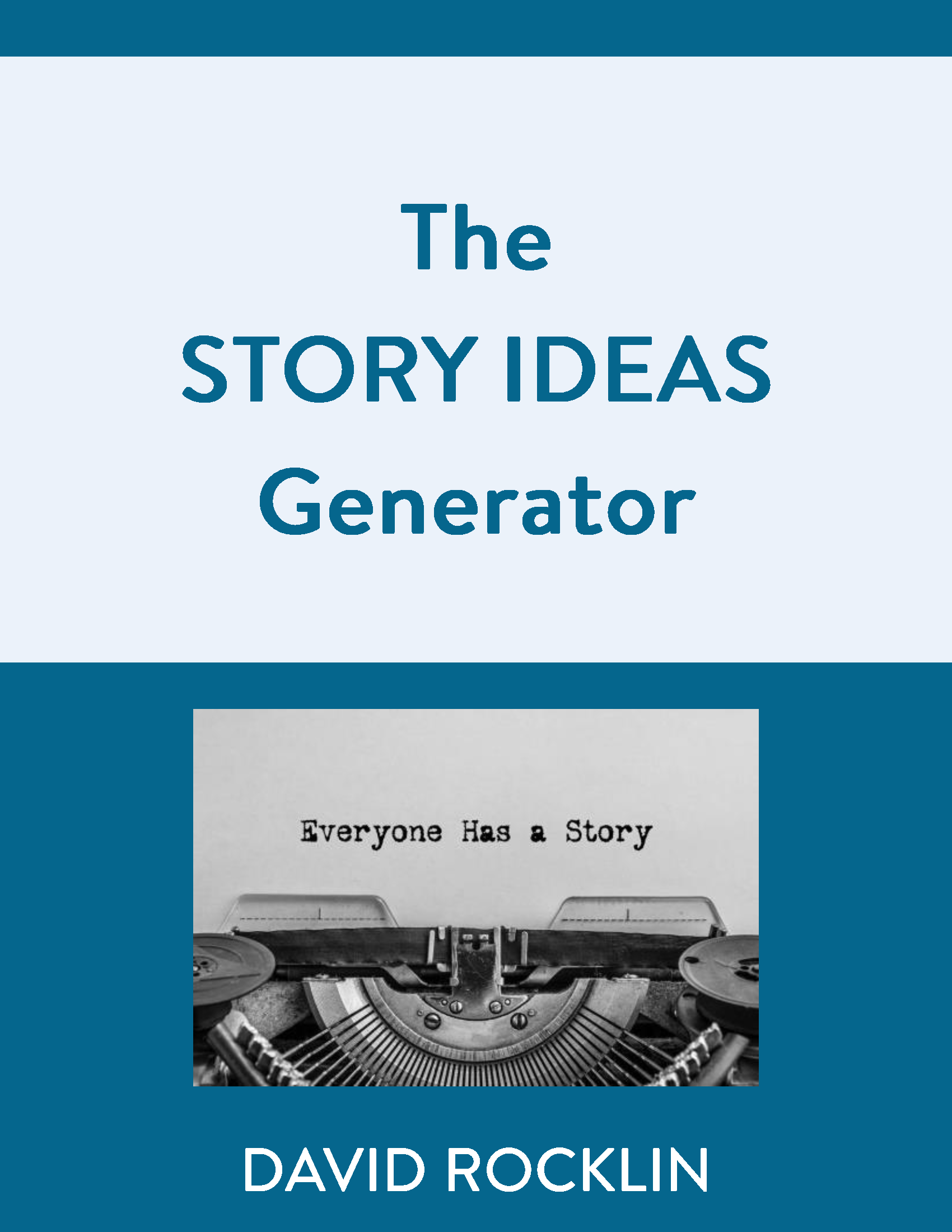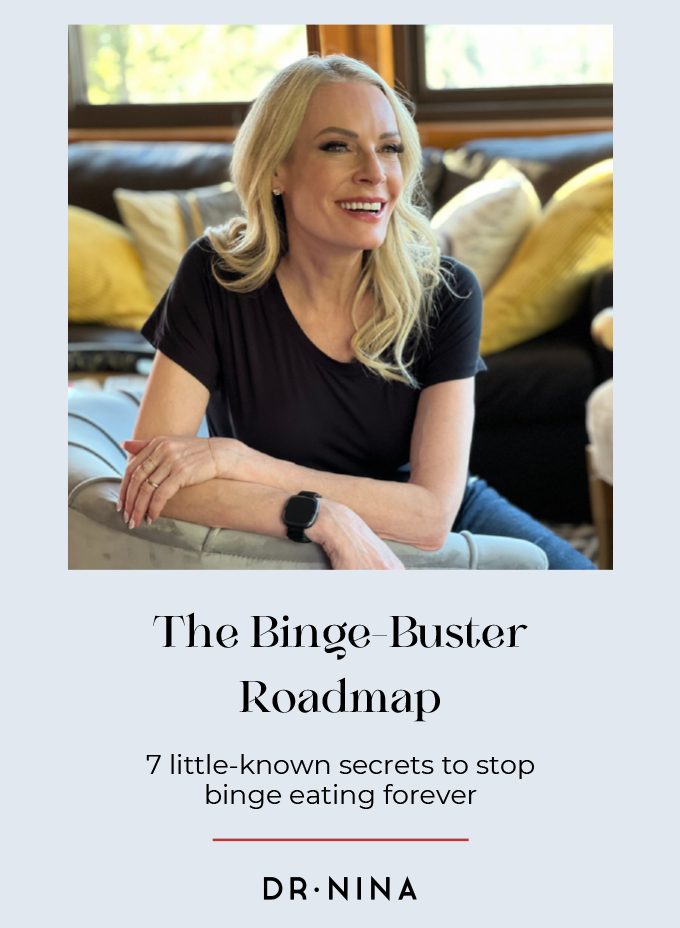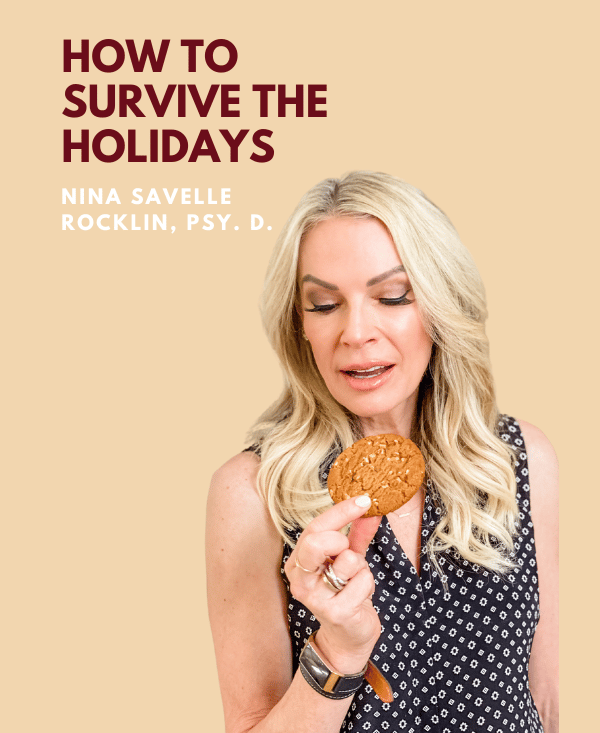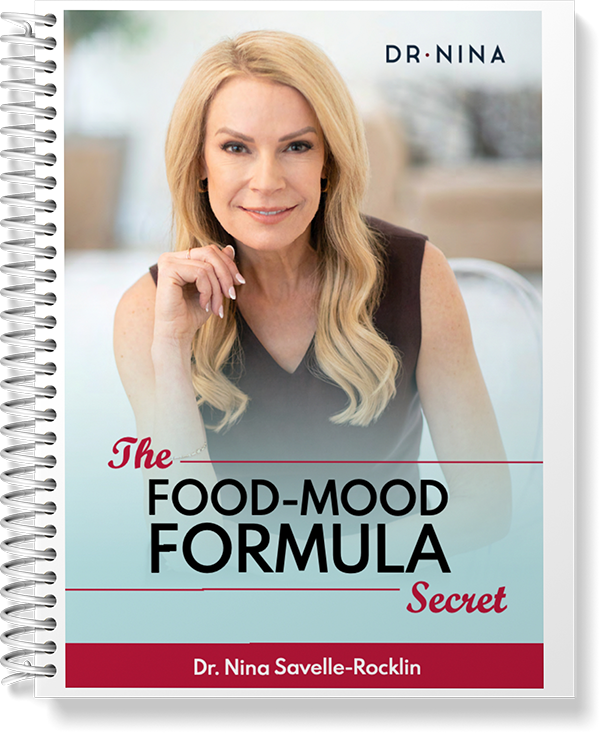Dr. Nina Savelle-Rocklin
Feeling bad about food? Here’s how to express your emotions

Table of Contents
- The Physicality of Emotions
- The Psychology of Emotions
- How to express your emotions
- Express Rather Than Suppress
- The Emotional Expression Template
- Jasmine’s story
We all have emotions. Some pleasant, some unpleasant, and some in between. When we don’t acknowledge our feelings or try to push them away, they can become overwhelming and lead to unhealthy behaviors such as binge eating.
Bingeing is often a way of coping with painful or upsetting states, which is why learning how to recognize and process your emotions is key to finding balance in life and creating healthy habits around food.
The first step in managing your emotions is recognizing what you are feeling. This can be difficult for those of us who ignore or try to suppress our feelings or sweep them under the rug.
Psychologists have identified six basic human emotions—anger, fear, sadness, joy, surprise, and disgust. All emotions can be distilled down into one of those on the list. For example, shame is associated with disgust. Frustration is a form of anger. Anxiety is a form of fear.
Each emotion has a distinct physiological response.
Knowing these responses can help us better identify our emotional states.
In this blog, I will first explore the different types of basic emotions and how to recognize them based on the way they manifest physically. Then, we’ll look at the psychology of recognizing emotions and how that relates to binge eating and emotional eating.
The Physicality of Emotions
Anger is usually triggered by the perception that something isn’t right or fair. It’s natural to feel angry when someone or something violates your boundaries or rights. Physically, anger is often expressed through increased heart rate and blood pressure as well as tension in muscles throughout the body. Recognizing these physical sensations can help you understand when you are feeling angry.
Fear typically arises from a perceived threat or danger. It’s an instinctive response that helps protect us from harm by preparing us to take action against a potential source of danger. Fear often manifests in physical symptoms such as shallow breathing, rapid heart rate, and tensing up of muscles throughout the body. Becoming aware of these physical signs can help you recognize when fear is present.
Sadness is most commonly experienced after a loss—of a person, place, thing, job opportunity, etc.—or when we feel overwhelmed by life circumstances beyond our control. It can also be caused by frustration over not being able to reach a desired goal or outcome despite hard work or effort put in towards achieving it.
Physically, sadness can manifest as a lack of energy as well as tightness in your chest. Crying can be a physical reaction to sadness (as well as to frustration and anger).
When we experience joy, our brains produce a cascade of neurochemicals like dopamine, oxytocin, serotonin, and endorphins. These chemicals work together to create a sense of well-being and contentment. Additionally, when we feel joy, the brain releases gamma-aminobutyric acid (GABA), which reduces anxiety levels by calming down overactive neurons in the central nervous system. Endorphins can also cause physical changes like increased energy levels and improved focus.
One of the most obvious signs of joy is smiling. Smiling not only signals that we are feeling joy but also triggers an emotional response in those around us—sometimes, even if they don’t realize it. Studies have found that smiles activate the reward centers in our brains, leading to increased feelings of happiness and satisfaction.
Surprise can be positive or negative, depending on the situation. A surprise announcement or marriage proposal differs from the sudden appearance of a stranger unexpectedly knocking on your door late at night. The most common physiological response to surprise is known as the fight or flight response that kicks into gear when we perceive a potential threat. That causes our heart to pound, our breathing to become rapid and shallow, and our muscles to tense up—all within seconds.
Disgust is an emotion that we feel in response to something that we perceive as unpleasant, dangerous, or unclean. It's usually triggered by the sight, smell, or taste of something that we find unpleasant, but can also be triggered by certain thoughts. Self-disgust, for example, is related to shame. When you feel disgust, your heart rate and blood pressure increase, and your breathing becomes shallower. You might also start to sweat or feel nauseous. These physical reactions help you either get away from the thing that's causing you to feel disgusted (flight) or fight it off (fight).
By paying attention to certain physical cues like heart rate, muscle tension, and breathing patterns—we can better recognize what we’re feeling. That’s the first step to processing your feelings.
The Psychology of Emotions
A lot of us think we’re triggered by food. Triggered by ice cream, chocolate, or anything with a carb. Yet, we’re not triggered by food. We’re triggered by a situation that we can’t see or possibly don’t want to look at.
Many people who binge as a coping strategy have no idea what they’re actually feeling or needing. They turn so quickly to food that they don’t recognize the underlying emotional or situational trigger.
When I first started working with eating disorder patients, I began to discover something new. I noticed that their so-called trigger foods had everything to do with their hidden emotions.
I realized that their food choices had everything to do with the emotions that they could not identify or even recognize.
In my clinical work, I discovered that we’re drawn to three basic categories of food when we’re upset:
- Creamy…
- Filling, and…
- Crunchy
When we crave ice cream or something creamy, it isn’t ice cream we really want—but rather, comfort. The key to change is finding new ways to comfort ourselves that don’t involve eating.
The second category is filling, food that takes up space within, such as bread, burgers, cake, pasta, or pizza. Those foods are related to emptiness since they symbolically fill an inner void. It’s important to take a look at the holes in our lives, the empty spaces, and find new ways to fill them.
Last is crunchy textures. Anything that makes us bite down hard is associated with forms of anger, like frustration or annoyance, irritation, and rage. Instead, the key is to express anger in a healthier way–with words.
As for chocolate, some of us only like milk chocolate or chocolate with creamy centers. Others won’t eat chocolate without nuts. Plain dark chocolate usually has a bit of a crunch.
That’s why chocolate is either creamy, associated with comfort, or crunchy, associated with forms of anger. Also, maybe we need more sweetness in our lives. Not the kind that comes from sugar but the sweetness of connection, fulfillment, and love.
This is what I call the Food-Mood Formula. Keep in mind that enjoying some chips with your sandwich is not the same as eating a family-size bag of Doritos and hating yourself with every bite.
The Food-Mood Formula only applies to situations when you feel a pull towards food to change the way you emotionally feel. By cultivating new strategies to express yourself, you stop using food to cope.
How to express your emotions
Once you've identified your emotions, it's important that you express them rather than suppress them. Trying to ignore or push away unpleasant feelings only amplifies them. We can’t ignore our emotions. We can’t get rid of feelings by dropping them, positive-thinking them away, dismissing them, or minimizing them. And we definitely can’t stuff them down.
Many of us don't know how to feel our feelings. That’s because our culture discourages emotionality. We get the message that we’re strong if we can push our emotions away and weak if we actually feel or express them. Feelings are also seen as problematic.
If we’re angry, we’re told to enroll in anger management classes. If we’re scared, we’re supposed to fight and not give in to fear. When we’re sad, we’re prescribed antidepressants. There’s a pill for anxiety, too.
Of course, some of us benefit from medication, but these are prohibitions against our basic human emotions that connect us to ourselves and each other.
With so many injunctions against emotions, it’s no wonder that so many of us don’t know how to comfort ourselves, be with ourselves, or respond to ourselves.
No wonder so many of us turn to food (or other behaviors or substances) as a way of coping.
The good news is that when we learn new ways of coping by expressing our emotions and responding to ourselves, we stop using food for the purpose of comforting, distracting, or numbing ourselves.
Express Rather Than Suppress
When it comes to processing our emotions, a lot of us are lost. Many people know they have to express themselves, but they don’t know how.
Recently a client asked, “So what do I do with these feelings? Just sit in them?”
Absolutely not.
We definitely can’t sit our way through feelings. And, it’s hard to “sit” with uncomfortable emotions, especially if we use coping strategies like bingeing to avoid that discomfort. That’s why having a strategy is important. At first, it may seem awkward to process your emotions, but with practice, it becomes second nature.
The Emotional Expression Template
First, identify your emotions using the Food-Mood Formula and pay attention to your physical reactions to situations.
Second, express yourself with words and tone. Write about what you are feeling and why. Describe the situation and how it makes you feel. Or talk to a trusted friend, or share in a group.
Third, respond to yourself by validating and acknowledging your experience. It’s important to get it all out without apology or guilt. We’re often told to “look on the bright side,” “be grateful,” or “it could have been worse.” These comments are not helpful; they are dismissive. In fact, some people then end up feeling bad about feeling bad. Once you validate and acknowledge what you’re going through emotionally, you’re going to feel better.
The only way to get rid of feelings is to feel them. But a lot of us use logic to avoid emotions. Keep in mind, when it comes to the human experience, it’s not logical. It’s psychological. Consider Jasmine’s situation as an example (not her real name).
Jasmine’s story
Jasmine is single, has a lot of great friends, and is a horrible boss. Think about Meryl Streep’s character in “The Devil Wears Prada,” who was scornful, insulting, dismissive, and unreasonable.
That character was an angel compared to Jasmine’s boss, who was openly scornful and belittling. Nothing Jasmine did was ever good enough.
One day, Jasmine came in for her session and confessed (which was the way she put it, “I have a confession to make”) that she’d binged all week.
She was upset with herself. Her weight disgusted her. She felt like a failure. She said she couldn’t do anything right.
I thought Jasmine sounded a lot like her boss, insulting and just plain mean. I suggested Jasmine was taking the anger she felt towards her boss and turning it on herself.
That resonated with Jasmine, and she nodded thoughtfully. A few moments later, she said, “That makes sense, but so what? How is that supposed to help me?”
She was going into her head as a way of staying out of her feelings. This is what’s called an intellectual defense, a way of avoiding emotions by getting very logical.
I explained to Jasmine that the way we talk to ourselves impacts the way we feel. The way we feel affects the way we eat.
If you’re self-critical, you’ll feel terrible and use food for comfort or distraction. That leads to more self-judgment and criticism. To stop that cycle, you have to change the way you relate to yourself
and your feelings.
In Jasmine’s situation, it was important for her to express her feelings about her boss so she wouldn’t direct them to herself. That did not mean talking to her boss directly. That would get her fired. Instead, it was crucial for her to express her frustration and disappointment so those emotions would not be available for her to turn against herself. When we express our emotions, we don’t need food to cope.
This did not resonate with Jasmine. She asked, “What’s the point of talking about my feelings?
It won’t change anything.”
In one sense, she was absolutely right. Her horrible boss was likely never going to change. Like Jasmine, we all have encountered people and situations that we can’t change. Yet, we don’t express our emotions to change a situation. We express ourselves so we change the way we experience that situation.
Most of us have experienced loss, the death of someone we know or love. When a loved one dies, we don’t say, “Well, they’re gone, and there’s nothing I can do about it, so what’s the point of crying?”
No, of course not. Whether we attend a wake or sit shiva or mourn in some other way, there are rituals to help us grieve the person we have lost.
We cry, we feel a terrible loss and emptiness, and then, when we have felt all the feelings, we eventually feel better. The person we lost lives on in our memory and our thoughts, but the intensity of that loss diminishes. The situation hasn’t changed, but it doesn’t hurt as much. The same principle applies to all emotions. By processing our emotions, the intensity diminishes.
Jasmine responded, “Well, the way the economy is, some people can’t get a job at all. A lot of people would be thrilled to be in my position. I have no right to complain about my boss.”
She was trying to minimize her feelings by comparing her situation to other people who have it worse. If you break your arm snowboarding and your best friend breaks a leg, that doesn’t make your broken arm less painful.
If your house is flooded and you need to redo all the flooring, and your neighbor’s house goes up in flames and burns to the ground, you still have a right to be upset about your situation.
If you want to lose fifty pounds, and your friend needs to lose 150, you get to feel upset about your weight even though your friend has more to lose.
We can all be thankful we’re not living in war-torn Ukraine or in Africa dealing with an AIDs epidemic and with other dire conditions. What’s happening in other parts of the world is tragic, but those situations don’t take away our right to be upset with the problems and issues that impact our lives.
Jasmine had a hard time being angry with her boss, but she found it easy to turn those angry feelings on herself. Bingeing did two things for her:
First, it was her way of avoiding anger – bingeing provided comfort and helped her numb her feelings.
Second, it also gave her a reason to direct that anger inwards. Instead of saying, “My boss is out of control, and I’m so upset at how I’m being treated,” she said, “See how out of control I am with food?”
If you dismiss or minimize your emotions, they don’t go away. They often get redirected toward themselves, which was the case with Jasmine.
You might be wondering why Jasmine had such a hard time being upset at her terrible boss.
As is often the case, the answer to a problem in the present can be found in the past. Jasmine’s parents worked long hours, and she spent most afternoons with her grandfather, who was a rageaholic. He didn’t get frustrated or irritated, or upset. He got furious. He expressed himself by yelling, finger-pointing, name-calling, sarcasm, and throwing things.
Jasmine grew up equating anger with being out-of-control and scary. On some level, Jasmine was afraid that if she got angry, she’d be just as bad, as threatening, and as scary as her grandfather. Her parents never showed much emotion – and they were always away, working – so she had no model for expressing anger in an appropriate way.
When we explored how her experience with her grandfather had influenced her ability to express these feelings, Jasmine gave another intellectual response. She said in a very matter-of-fact way, “I guess I can see how a person would have resentment towards a grandfather like that. I can see how a person would be affected by that.”
Notice how she talked about how “a person would have resentment toward a grandfather like that” instead of how “she” felt having a close relative whose anger terrified her. Jasmine was eventually able to express how she felt about her grandfather, as well as her boss. She got mad, outraged, and incensed. She let loose with some very creative swear words.
She got out all her anger, and when she did that, she stopped being so hard herself.
That’s when she stopped bingeing.
If you find yourself saying things like, “What’s the point of talking about it? It won’t change anything.”
Or, “Other people have it so much worse than me. I have no right to complain.”
If you talk about how “people” might feel in your situation rather than how “you” feel, you might be too much in your head and not enough in your heart.
Whether you’re trying to minimize your anger, like Jasmine, or other feelings like sadness, helplessness, anxiety, fear, guilt, worry, or shame, those emotions need your attention.
When you think less and feel more, you’ll stop eating for comfort or distraction. By expressing yourself and getting out of your head, you’ll stay out of the fridge.
Sick of obsessing about every bite?
GET THE CURE
The Binge Cure Book!
Enter “CURE” to receive a 20% discount.
No, I don’t want access to this terrific resource to help me overcome binge eating.
The Author

Dr. Nina Savelle-Rocklin is a renowned author and podcast host and one of the nation’s leading psychoanalysts known for the psychology of eating. Her signature message of, “It’s not what you’re eating, it’s what’s eating ‘at’ you” has resonated with hundreds of thousands of listeners from around the globe in 40 countries. As founder of The Binge Cure Method, she guides emotional eaters to create lasting food freedom so they can take back control of their lives and feel good in their bodies.
Related Blogs

